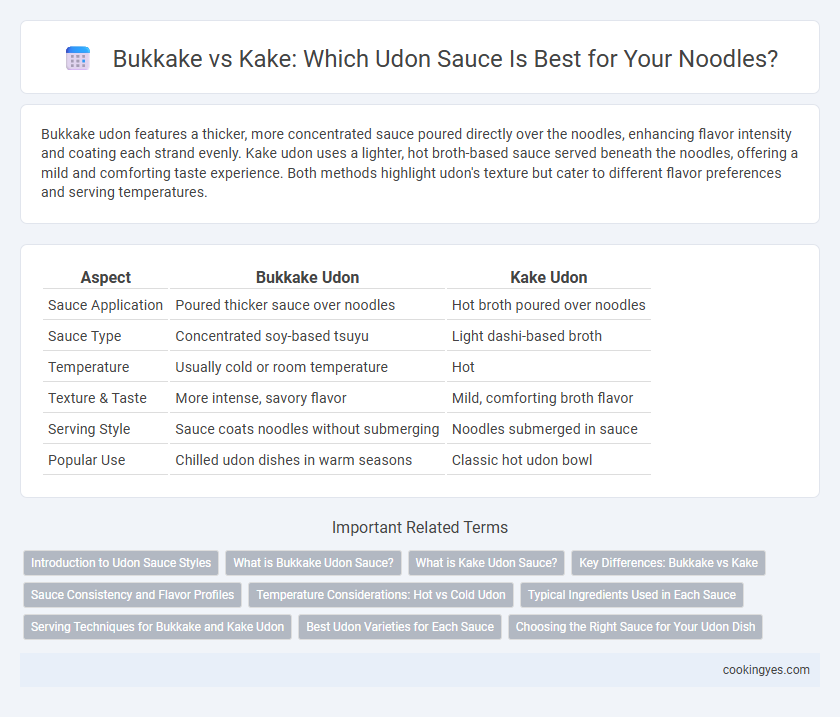Bukkake udon features a thicker, more concentrated sauce poured directly over the noodles, enhancing flavor intensity and coating each strand evenly. Kake udon uses a lighter, hot broth-based sauce served beneath the noodles, offering a mild and comforting taste experience. Both methods highlight udon's texture but cater to different flavor preferences and serving temperatures.
Table of Comparison
| Aspect | Bukkake Udon | Kake Udon |
|---|---|---|
| Sauce Application | Poured thicker sauce over noodles | Hot broth poured over noodles |
| Sauce Type | Concentrated soy-based tsuyu | Light dashi-based broth |
| Temperature | Usually cold or room temperature | Hot |
| Texture & Taste | More intense, savory flavor | Mild, comforting broth flavor |
| Serving Style | Sauce coats noodles without submerging | Noodles submerged in sauce |
| Popular Use | Chilled udon dishes in warm seasons | Classic hot udon bowl |
Introduction to Udon Sauce Styles
Bukkake and Kake are two popular udon sauce styles that highlight distinct flavor profiles and serving methods. Bukkake udon involves pouring a concentrated, flavorful broth over chilled or warm noodles, creating a rich and intense taste experience. Kake udon features a lighter, hot dashi-based soup that fully submerges the noodles, offering a comforting and mild flavor ideal for traditional udon enjoyment.
What is Bukkake Udon Sauce?
Bukkake udon sauce is a concentrated, flavorful broth poured directly over cold or hot udon noodles, enhancing their texture and taste without diluting the flavor. This sauce typically includes a mix of soy sauce, dashi, mirin, and sometimes grated daikon or ginger, offering a robust umami experience. Unlike kake udon, where hot broth fully submerges the noodles, bukkake uses less liquid, allowing the sauce to cling to the noodles for a more intense savory bite.
What is Kake Udon Sauce?
Kake udon sauce is a light, clear broth made from dashi, soy sauce, and mirin, serving as the base for hot udon noodle soups. Unlike bukkake sauce, which is concentrated and poured over cold or chilled udon, kake udon sauce is diluted and poured hot to complement udon noodles in a soup-style dish. This broth emphasizes a delicate balance of umami and subtle sweetness, enhancing the warm comfort of traditional kake udon.
Key Differences: Bukkake vs Kake
Bukkake udon features a concentrated, thick soy-based sauce poured directly over the noodles, enhancing flavor intensity and providing a more robust taste experience. Kake udon uses a lighter, hot broth made from dashi, soy sauce, and mirin, resulting in a clear, warm soup that gently coats the noodles. The key difference lies in bukkake's emphasis on sauce coating versus kake's traditional soup presentation.
Sauce Consistency and Flavor Profiles
Bukkake udon features a thicker, more concentrated sauce that clings to the noodles, providing a robust and savory flavor profile often enriched with soy sauce, mirin, and dashi. Kake udon uses a lighter, more diluted broth that allows the subtle umami of dashi and kombu to shine, resulting in a delicate and soothing taste. The consistency of bukkake sauce enhances the boldness of toppings, while kake broth complements the noodles with its gentle, soupy texture.
Temperature Considerations: Hot vs Cold Udon
Bukkake udon is typically served with a cold or room-temperature tsuyu sauce poured over chilled noodles, emphasizing refreshing and crisp flavors ideal for warm weather. Kake udon, on the other hand, features hot udon noodles submerged in a steaming bowl of hot broth, enhancing the warming and comforting qualities of the dish during colder seasons. Temperature considerations directly impact the sauce's viscosity and flavor intensity, with hot kake broth intensifying umami, while cold bukkake sauce maintains a lighter, more delicate taste profile.
Typical Ingredients Used in Each Sauce
Bukkake udon sauce typically contains a concentrated blend of dashi, soy sauce, mirin, and sugar to create a rich, savory flavor that is poured over the noodles. Kake udon sauce, in contrast, features a lighter broth primarily made from dashi, soy sauce, and mirin, designed to warmly soak the noodles without overpowering them. The key difference lies in the sauce concentration and sweetness, with bukkake sauce offering a thicker, more robust taste while kake sauce remains subtle and comforting.
Serving Techniques for Bukkake and Kake Udon
Bukkake udon involves pouring a concentrated sauce mixture directly over cold or warm noodles, enhancing the textural contrast with toppings like grated radish or tempura bits. Kake udon features a hot, clear broth poured generously over noodles, emphasizing warmth and simplicity, typically garnished with green onions or fish cake. Both serving techniques highlight different flavor profiles and temperatures, providing unique udon dining experiences.
Best Udon Varieties for Each Sauce
Thick Sanuki udon pairs best with bukkake sauce, as its firm texture holds up well under the concentrated, chilled broth, enhancing the bold flavors. For kake sauce, which is served hot and lighter in flavor, softer, thinner Inaniwa udon varieties excel by absorbing the warm dashi-based soup evenly without overpowering the palate. Choosing the appropriate udon thickness and texture directly impacts the balance and enjoyment of either bukkake or kake sauce applications.
Choosing the Right Sauce for Your Udon Dish
Bukkake udon is served with a thicker, concentrated sauce poured directly over the noodles, enhancing the dish's rich umami flavor and providing a more intense taste experience. Kake udon features a lighter, hot broth poured around the noodles, creating a soothing, subtle flavor ideal for showcasing toppings and the noodles' texture. Selecting between bukkake and kake sauce depends on whether you prefer a bold, savory punch or a delicate, comforting soup base for your udon.
Bukkake vs Kake for udon sauce application Infographic

 cookingyes.com
cookingyes.com